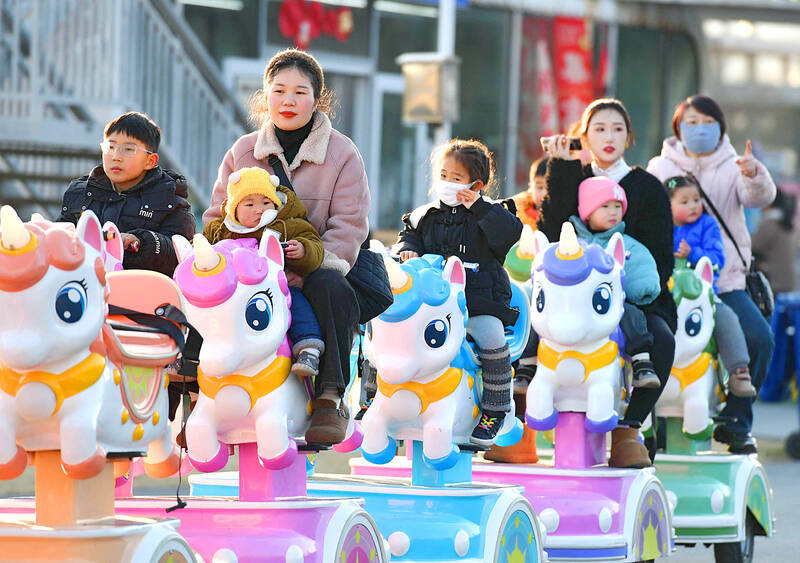China’s population fell for a third consecutive year last year, with the number of deaths outpacing a slight increase in births, and experts cautioning that the trend would accelerate in the coming years.
The Chinese National Bureau of Statistics said the total number of people in the nation dropped by 1.39 million to 1.408 billion last year, compared with 1.409 billion in 2023.
The data released yesterday reinforced concerns that the world’s second-largest economy would struggle as the number of workers and consumers declines.

Photo: AFP
Rising costs from elderly care and retirement benefits are also likely to create additional strains for already indebted local governments.
The total number of births last year was 9.54 million versus 9.02 million in 2023, the bureau said.
The birthrate rose to 6.77 births per 1,000 people last year versus 6.39 per 1,000 people in 2023.
The number of deaths was 10.93 million last year from 11.1 million in 2023.
China’s birthrate has been falling for decades as a result of the one-child policy Beijing implemented from 1980 to 2015 as well as rapid urbanization.
As in Japan and South Korea, large numbers of Chinese have moved from rural farms to cities, where having children is more expensive.
The high cost of childcare and education, job uncertainty and a slowing economy have also discouraged many young Chinese from getting married and starting a family.
Gender discrimination and traditional expectations for women to take care of the home exacerbate the issue, demographers say.
“Much of China’s population decline is rooted in entrenched structural reasons: Without fundamental structural transformations — from enhancing the social safety net to eliminating gender discrimination — the trend of population decline cannot be reversed,” said Yun Zhou, an assistant professor of sociology at the University of Michigan.
A 12.4 percent rise in marriages in 2023 — many delayed due to the COVID-19 pandemic — accounted for the rebound in births last year, but the number is expected to fall again this year, demographers said.
Marriages are a leading indicator for the birthrate in China, where many single women cannot access child-raising benefits.
Authorities last year introduced a series of measures to boost the nation’s birth rate.
Last month, they urged colleges and universities to integrate marriage and “love education” into their curriculums to emphasize positive views on marriage, love, fertility and family.
In November, China’s State Council rallied local governments to direct resources towards fixing the nation’s population crisis and spread respect for childbearing and marriages “at the right age.”
The number of Chinese women of reproductive age, defined by the UN as 15 to 49, is set to drop by more than two-thirds to under 100 million by the end of the century.
Meanwhile, the retirement-age population — those aged 60 and over — is expected to increase to more than 400 million by 2035 from about 280 million people now.
The state-run Chinese Academy of Sciences has said the pension system would run out of funds by 2035.
About 22 percent of China’s population, or 310.31 million people, were aged 60 or over last year, against 296.97 million in 2023, the data showed.
Urbanization also gathered pace with the number of people living in cities up by 10.83 million to 943.3 million. The rural population declined to 464.78 million.

Shamans in Peru on Monday gathered for an annual New Year’s ritual where they made predictions for the year to come, including illness for US President Donald Trump and the downfall of Venezuelan President Nicolas Maduro. “The United States should prepare itself because Donald Trump will fall seriously ill,” Juan de Dios Garcia proclaimed as he gathered with other shamans on a beach in southern Lima, dressed in traditional Andean ponchos and headdresses, and sprinkling flowers on the sand. The shamans carried large posters of world leaders, over which they crossed swords and burned incense, some of which they stomped on. In this

The death of a former head of China’s one-child policy has been met not by tributes, but by castigation of the abandoned policy on social media this week. State media praised Peng Peiyun (彭珮雲), former head of China’s National Family Planning Commission from 1988 to 1998, as “an outstanding leader” in her work related to women and children. The reaction on Chinese social media to Peng’s death in Beijing on Sunday, just shy of her 96th birthday, was less positive. “Those children who were lost, naked, are waiting for you over there” in the afterlife, one person posted on China’s Sina Weibo platform. China’s

‘NO COUNTRY BUMPKIN’: The judge rejected arguments that former prime minister Najib Razak was an unwitting victim, saying Najib took steps to protect his position Imprisoned former Malaysian prime minister Najib Razak was yesterday convicted, following a corruption trial tied to multibillion-dollar looting of the 1Malaysia Development Berhad (1MDB) state investment fund. The nation’s high court found Najib, 72, guilty on four counts of abuse of power and 21 charges of money laundering related to more than US$700 million channeled into his personal bank accounts from the 1MDB fund. Najib denied any wrongdoing, and maintained the funds were a political donation from Saudi Arabia and that he had been misled by rogue financiers led by businessman Low Taek Jho. Low, thought to be the scandal’s mastermind, remains

Australian Prime Minister Anthony Albanese yesterday announced plans for a national bravery award to recognize civilians and first responders who confronted “the worst of evil” during an anti-Semitic terror attack that left 15 dead and has cast a heavy shadow over the nation’s holiday season. Albanese said he plans to establish a special honors system for those who placed themselves in harm’s way to help during the attack on a beachside Hanukkah celebration, like Ahmed al-Ahmed, a Syrian-Australian Muslim who disarmed one of the assailants before being wounded himself. Sajid Akram, who was killed by police during the Dec. 14 attack, and